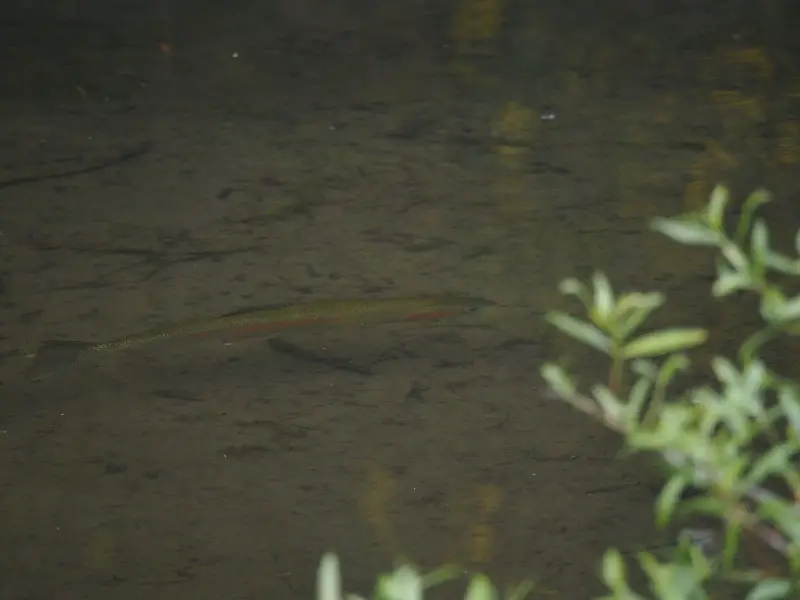Sighting trout, even in clear conditions can be difficult. Their camouflaged backs have evolved to be nearly invisible from above.
Their patterns and coloration are designed to trick the razor sharp eyes of birds of prey. An osprey’s eyesight is 3-5 times stronger than ours, such vision is what trout evolve to hide against. The odds of us sighting them is certainly not in our favor.
I have read, that fishermen only see a fraction of the total number of trout in a river, and I believe that. I have fish runs and pools and might see a couple of trout. Later I drift dive the same run and will see dozens more. They are exceptionally well adapted to avoiding detection from above.
This article will provide some hints on how to even out the odds. To improve the chances of spotting fish.
Before I get started on the list, always wear the proper gear. Polarized sunglasses and a wide brim hat massively reduces the glare which is an enormous help when sight fishing. If sight fishing, they are nearly essential.

1) Look for movement
One of the first things I look for is movement that is out of sync with the rest of the current.
At first, it is very difficult to see the fish but it is sometimes possible to see movement which is not caused by the reflection of the water.
Maybe it will be a darker patch that just seems to be moving out of sync. Sometimes the white flash of a feeding fish can also give their position away.
2) Look for Shadow
I rarely try and spot the trout themselves, they are very well camouflaged, but their shadow is not. I look for the darker outline towards the bottom which suggests there is something suspended in the water column.
3) Look for branches and oblong rocks
Trout, submerged branches, and elongated rocks all have one thing in common. They can look like each other when at the bottom of a pool.
If you see a rock, or branch which looks somewhat fishy and is facing into the current it is always worth making a few casts. I’ve been sight fishing for years and still frequently mistake trout for rocks and vice versa. There is nothing worse when a large ‘rock’ swims away to cover.
If it looks like it could be a trout, treat it as one.
4) Gain elevation
A higher vantage point makes looking down into the river so much easier, higher elevations make spotting fish significantly easier.
Although, it works in reverse and also makes it much easier for the trout to see the angler.
I often climb a cliff or large boulder, just to give an area a good scan, to try and find where the trout are holding. Then I will sneak back down and use my new knowledge to concentrate on the areas where I saw the fish.
When fishing with a friend, sometimes it is a good idea to work as a team. One person spots from a vantage point, and guide the other angler to the fish.
5)Read the water
Reading the water is a skill in its own right, by understanding the currents and flow patterns. It is possible to understand where the trout are most likely to be holding. A classic example is either behind or in front of a large boulder or rock out in the current. That is because the rock split the current, creating an area of relatively little flow. Trout being lazy, are more likely to set there.
Likewise, trout are more likely to hold towards the edges, because the eddies create a back current and the trout can feed there without wasting energy to maintain their position.
If you know the locations where the trout are most likely to be feeding, they become so much easier to spot.
6) Know the water
Why do you think guides can spot trout so quickly and effortlessly?
Do they have excellent sight fishing skills gained from years of experience? Probably. But more importantly, they usually know the river they are guiding like the back of their hand.
They have seen the trout, and where they hold countless times before. Once you know the most likely holding spots of a trout in a river, it becomes significantly easier to spot trout the next time you fish that location.
7) Look for openings or windows in the ripples
Stare at a current for long enough, and eventually, a calm patch of water will appear. These calm spots, while only lasting a second or two act like a window into the river below greatly improving the chances of seeing what lay below.
Even just a glimpse is enough to keep track of a fish.
8) Practice, practice, practice
Practice spotting fish every chance you have. The more you practice sight fishing the easier it becomes. Whenever I am walking beside water, much to my wife’s annoyance, I always try and spot fish.
It does not matter if the stream holds trout or not, I am going to try and sight fish. I also search for them in the ocean while beach walking.
9) Sun position makes a difference
This one is obvious, but looking into the sun is difficult at the best of times, so trying to sight fish with the sun in your eyes is difficult.
Try and fish with either the sun directly overhead or behind you. It makes spotting trout much easier. Directly overhead is typically best, not only is there less glare but there is no chance that your own shadow while casting will spook fish.
10) Fish slowly, take your time
When sight fishing it is so easy to walk too fast and end up spooking fish. I have lost count of the number of times I have never stood on a trout that was resting in the shallows.
When sight fishing take your time and give every spot a good looking over before moving on upstream. Trout are difficult to see, and if you go too fast the majority of trout will end up being spooked.
Summary
These were my 10 quick tips to sight more trout when fishing. I have a more detailed guide here that provides additional information.


